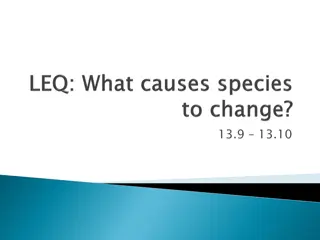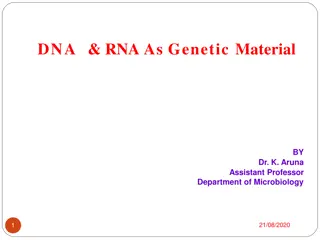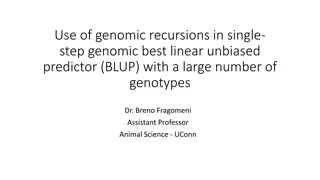Understanding the Flow of Genetic Information
The flow of genetic information involves the transmission of DNA content into specific protein synthesis through the processes of transcription and translation. Genes dictate the traits of an organism by directing the production of proteins, which serve as the connection between genotype and phenotype. The central dogma of molecular biology outlines the cellular chain of command from DNA to RNA to protein, illustrating the fundamental process governing genetic expression.
Download Presentation

Please find below an Image/Link to download the presentation.
The content on the website is provided AS IS for your information and personal use only. It may not be sold, licensed, or shared on other websites without obtaining consent from the author. Download presentation by click this link. If you encounter any issues during the download, it is possible that the publisher has removed the file from their server.
E N D
Presentation Transcript
The Flow of Genetic Information The information content of DNA is in the form of specific sequences of nucleotides The DNA inherited by an organism leads to specific traits by dictating the synthesis of proteins Proteins are the links between genotype and phenotype Gene expression, the process by which DNA directs protein synthesis, includes two stages: transcription and translation
The Products of Gene Expression: A .Developing Story Some proteins aren t enzymes, so researchers later revised the hypothesis: one gene one protein Many proteins are composed of several polypeptides, each of which has its own gene Therefore, Beadle and Tatum s hypothesis is now restated as the one gene one polypeptide hypothesis
RNA is the bridge between genes and the proteins for which they code Transcription is the synthesis of RNA using information in DNA Transcription produces messenger RNA (mRNA) Translation is the synthesis of a polypeptide, using information in the mRNA Ribosomes are the sites of translation
In prokaryotes, translation of mRNA can begin before transcription has finished In a eukaryotic cell, the nuclear envelope separates transcription from translation Eukaryotic RNA transcripts are modified through RNA processing to yield the finished mRNA A primary transcript is the initial RNA transcript from any gene prior to processing The central dogma is the concept that cells are governed by a cellular chain of command: DNA RNA protein
Nuclear envelope DNA TRANSCRIPTION Pre-mRNA RNA PROCESSING mRNA DNA TRANSCRIPTION mRNA Ribosome TRANSLATION Ribosome TRANSLATION Polypeptide Polypeptide (a) Bacterial cell (b) Eukaryotic cell
Codons: Triplets of Nucleotides The flow of information from gene to protein is based on a triplet code: a series of nonoverlapping, three-nucleotide words The words of a gene are transcribed into complementary nonoverlapping three- nucleotide words of mRNA These words are then translated into a chain of amino acids, forming a polypeptide
Figure 17.4 DNA template strand DNA molecule 5 3 A A A A A T C C C C G G T T T T A G G G G C T C Gene 1 3 5 TRANSCRIPTION Gene 2 U G G U U U G G C U C A 5 3 mRNA Codon TRANSLATION Gly Phe Trp Ser Protein Gene 3 Amino acid
During transcription, one of the two DNA strands, called the template strand, provides a template for ordering the sequence of complementary nucleotides in an RNA transcript The template strand is always the same strand for a given gene During translation, the mRNA base triplets, called codons, are read in the 5 to 3 direction
Codons along an mRNA molecule are read by translation machinery in the 5 to 3 direction Each codon specifies the amino acid (one of 20) to be placed at the corresponding position along a polypeptide
Cracking the Code All 64 codons were deciphered by the mid- 1960s Of the 64 triplets, 61 code for amino acids; 3 triplets are stop signals to end translation The genetic code is redundant (more than one codon may specify a particular amino acid) but not ambiguous; no codon specifies more than one amino acid Codons must be read in the correct reading frame (correct groupings) in order for the specified polypeptide to be produced
Figure 17.5 Second mRNA base C A U G UUU UAU UCU UGU U Phe Cys Tyr UUC UCC UAC UGC C U Ser UUA UCA UGA Stop A UAA Stop Leu Trp UUG UCG UGG G UAG Stop Third mRNA base (3 end of codon) CUU CCU U CAU CGU First mRNA base (5 end of codon) His CUC CAC CGC C CCC C Leu Pro Arg CUA CCA CGA A CAA Gln CUG CCG CGG G CAG AUU AAU ACU AGU U Ser Asn Ile C AUC AAC ACC AGC A Thr AUA AAA ACA AGA A Lys Arg Met or start AUG ACG AGG AAG G GUU GCU GAU GGU U Asp GUC GCC C GGC GAC G Val Ala Gly Gly GUA GCA GGA A GAA Glu GUG GCG GGG G GAG
Evolution of the Genetic Code The genetic code is nearly universal, shared by the simplest bacteria to the most complex animals Genes can be transcribed and translated after being transplanted from one species to another
Molecular Components of Transcription RNA synthesis is catalyzed by RNA polymerase, which pries the DNA strands apart and hooks together the RNA nucleotides The RNA is complementary to the DNA template strand RNA synthesis follows the same base-pairing rules as DNA, except that uracil substitutes for thymine
The DNA sequence where RNA polymerase attaches is called the promoter; in bacteria, the sequence signaling the end of transcription is called the terminator The stretch of DNA that is transcribed is called a transcription unit
Figure 17.7-4 Promoter Transcription unit 5 3 3 5 DNA Start point RNA polymerase 1 Initiation Nontemplate strand of DNA 3 5 5 3 Template strand of DNA RNA transcript Unwound DNA 2 Elongation Rewound DNA 3 5 5 3 3 5 RNA transcript 3 Termination 3 5 3 5 3 5 Completed RNA transcript Direction of transcription ( downstream )























